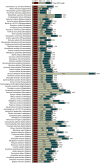The ubiquity and ancestry of insect doublesex
- PMID: 26278009
- PMCID: PMC4538375
- DOI: 10.1038/srep13068
The ubiquity and ancestry of insect doublesex
Abstract
The doublesex (dsx) gene functions as a molecular switch at the base of the insect sex determination cascade, and triggers male or female somatic sexual differentiation in Drosophila. Having been reported from only seven current insect orders, the exact phylogenetic distribution of dsx within the largest Arthropod sub-phylum, the Hexapoda, is unknown. To understand the evolution of this integral gene relative to other arthropods, we tested for the presence of dsx within public EST and genome sequencing projects representative of all 32 hexapod orders. We find the dsx gene to be ubiquitous, with putative orthologs recovered from 30 orders. Additionally, we recovered both alternatively spliced and putative paralogous dsx transcripts from several orders of hexapods, including basal lineages, indicating the likely presence of these characteristics in the hexapod common ancestor. Of note, other arthropods such as chelicerates and crustaceans express two dsx genes, both of which are shown to lack alternative splicing. Furthermore, we discovered a large degree of length heterogeneity in the common region of dsx coding sequences within and among orders, possibly resulting from lineage-specific selective pressures inherent to each taxon. Our work serves as a valuable resource for understanding the evolution of sex determination in insects.
Figures



Similar articles
-
Functional conservation and divergence of intersex, a gene required for female differentiation in Drosophila melanogaster.Dev Genes Evol. 2005 Jan;215(1):1-12. doi: 10.1007/s00427-004-0445-x. Epub 2004 Nov 12. Dev Genes Evol. 2005. PMID: 15645316
-
Genomic organization and splicing evolution of the doublesex gene, a Drosophila regulator of sexual differentiation, in the dengue and yellow fever mosquito Aedes aegypti.BMC Evol Biol. 2011 Feb 10;11:41. doi: 10.1186/1471-2148-11-41. BMC Evol Biol. 2011. PMID: 21310052 Free PMC article.
-
intersex, a gene required for female sexual development in Drosophila, is expressed in both sexes and functions together with doublesex to regulate terminal differentiation.Development. 2002 Oct;129(20):4661-75. doi: 10.1242/dev.129.20.4661. Development. 2002. PMID: 12361959
-
Double nexus--Doublesex is the connecting element in sex determination.Brief Funct Genomics. 2015 Nov;14(6):396-406. doi: 10.1093/bfgp/elv005. Epub 2015 Mar 22. Brief Funct Genomics. 2015. PMID: 25797692 Free PMC article. Review.
-
Doublesex: a conserved downstream gene controlled by diverse upstream regulators.J Genet. 2010 Sep;89(3):341-56. doi: 10.1007/s12041-010-0046-6. J Genet. 2010. PMID: 20877001 Review.
Cited by
-
doublesex alters aggressiveness as a function of social context and sex in the polyphenic beetle Onthophagus taurus.Anim Behav. 2017 Oct;132:261-269. doi: 10.1016/j.anbehav.2017.08.011. Epub 2017 Sep 19. Anim Behav. 2017. PMID: 28966347 Free PMC article.
-
Independent evolution for sex determination and differentiation in the DMRT family in animals.Biol Open. 2019 Aug 9;8(8):bio041962. doi: 10.1242/bio.041962. Biol Open. 2019. PMID: 31399444 Free PMC article.
-
Doublesex mediates species-, sex-, environment- and trait-specific exaggeration of size and shape.Proc Biol Sci. 2021 Jun 30;288(1953):20210241. doi: 10.1098/rspb.2021.0241. Epub 2021 Jun 23. Proc Biol Sci. 2021. PMID: 34157867 Free PMC article.
-
Rapid parallel adaptation despite gene flow in silent crickets.Nat Commun. 2021 Jan 4;12(1):50. doi: 10.1038/s41467-020-20263-4. Nat Commun. 2021. PMID: 33397914 Free PMC article.
-
Genetic architecture and sex-specific selection govern modular, male-biased evolution of doublesex.Sci Adv. 2019 May 8;5(5):eaau3753. doi: 10.1126/sciadv.aau3753. eCollection 2019 May. Sci Adv. 2019. PMID: 31086812 Free PMC article.
References
MeSH terms
Substances
LinkOut - more resources
Full Text Sources
Other Literature Sources
Molecular Biology Databases
Research Materials

